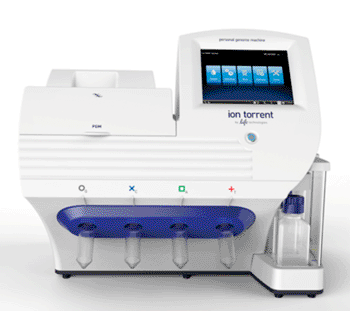Rapid Whole Genome Sequencing Detects Microorganisms from Clinical Samples
By LabMedica International staff writers
Posted on 23 Dec 2013
A technique known as whole genome sequencing (WGS) has been used to identify and completely characterize bacteria causing urinary tract infections.Posted on 23 Dec 2013
Application of this technology will help patients heal more quickly and avoid unnecessarily prolonged illness, help prevent outbreaks of hospital-acquired disease, and identify emerging infections.

Image: The Ion Torrent Personal Genome Machine (PGM) (Photo courtesy of Life Technologies).
Scientists at the Danish Technical University (Lyngby, Denmark) evaluated the applicability of WGS directly on clinical samples and developed easy-to-use bioinformatics tools for analysis of the sequenced data. They examined 35 random urine samples from patients with suspected urinary tract infections using conventional microbiology, WGS of isolated bacteria, and by directly sequencing on pellets from the urine. The 129 isolates were sequenced on the Ion Torrent Personal Genome Machine (PGM) (Life Technologies; Carlsbad, CA, USA).
Complete agreement was observed between species identification, multilocus-sequence typing, and phylogenetic relationship for the Escherichia coli and Enterococcus faecalis isolates when comparing the results of WGS of cultured isolates directly from urine samples. The investigators also identified bacteria in the patient samples that they did not detect using conventional techniques. Lactobacillus iners, Gardnerella vaginalis, Prevotella, and Aerococcus urinae have all been implicated in urinary tract infections, even though their precise roles as pathogens and normal colonizers of the genital tract have not been firmly established. They noted that by conventional methods A. urinae is rarely identified but frequently misclassified.
Sequencing directly from the urine enabled bacterial identification in polymicrobic samples and additional putative pathogenic strains were observed in some culture negative samples. This technique allowed the scientists in just 18 hours, to identify the microorganisms, characterized the pathogens' patterns of antibiotic susceptibility, and identified specific strains.
Frank M. Aarestrup, DVM, PhD, the senior author of the study said, “Using conventional methodologies this would have taken several days to weeks, and even using whole genome sequencing on cultured bacteria would have taken an extra day. Rapid identification of the causative agent and of any antibiotic resistance is crucial to choosing the correct treatment for individual patients. Choosing the wrong antibiotic will lead to longer infections and in the worst case, deaths.” The study was published online on October 10, 2013, in the Journal of Clinical Microbiology.
Related Links:
Danish Technical University
Life Technologies













